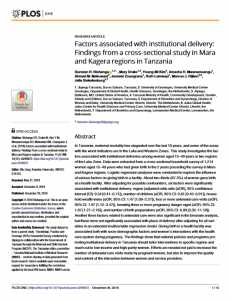
Abstract
In Tanzania, maternal mortality has stagnated over the last 10 years, and some of the areas with the worst indicators are in the Lake and Western Zones. This study investigates the factors associated with institutional deliveries among women aged 15–49 years in two regions of the Lake Zone. Data were extracted from a cross-sectional household survey of 1,214 women aged 15–49 years who had given birth in the 2 years preceding the survey in Mara and Kagera regions. Logistic regression analyses were conducted to explore the influence of various factors on giving birth in a facility. About two-thirds (67.3%) of women gave birth at a health facility. After adjusting for possible confounders, six factors were significantly associated with institutional delivery: region (adjusted odds ratio [aOR], 95% confidence interval [CI]: 0.54 [0.41–0.71]), number of children (aOR, 95% CI: 0.61 [0.42–0.91]), household wealth index (aOR, 95% CI: 1.47 [1.09–2.27]), four or more antenatal care visits (aOR, 95% CI: 1.97 [1.12–3.47]), knowing three or more pregnancy danger signs (aOR, 95% CI: 1.87 [1.27–2.76]), and number of birth preparations (aOR, 95% CI: 6.09 [3.32–11.18]). Another three factors related to antenatal care were also significant in the bivariate analysis, but these were not significantly associated with place of delivery after adjusting for all variables in an extended multivariable regression model. Giving birth in a health facility was associated both with socio-demographic factors and women’s interactions with the health care system during pregnancy. The findings show that national policies and programs promoting institutional delivery in Tanzania should tailor interventions to specific regions and reach out to low-income and high-parity women. Efforts are needed not just to increase the number of antenatal care visits made by pregnant women, but also to improve the quality and content of the interaction between women and service providers.
Access the original article and any supplementary material here.